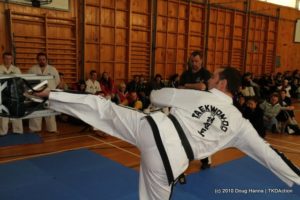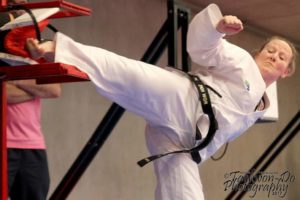
The reverse turning kick / bandae dollyo chagi is an iconic Taekwon-Do kicking technique. It is one of the harder techniques to break boards with, so here are some tips to help you.
Conditioning
Conditioning for power breaking in general consists of two choices. Don’t get hurt and don’t progress. Or do, and be able to train and perform safely and effectively. Here’s an example progression for conditioning for reverse turning kicks:
- Drum heels on mats for a few weeks
- Drum heels on carpet for a few months
- Drum heels on concrete
Knee bend
You need to feel comfortable with your knee angle, but still meet the technical requirements of the kick. Locking your leg completely straight is great if you’ve got very strong hamstrings or are breaking light boards. If you’re hypermobile (your knee can bend backwards a little) or you’re hitting high numbers of boards, or are not succeeding every time, you might want to bend your kicking knee a little. It should be enough to protect your joint, but not enough to be noticeably kinked. It should still look like a reverse turning kick.
Tool / angle
The encyclopedia of Taekwon-Do give two tools for this kick. The primary tool is dwitchook, the backheel. This is the base of your foot, where your Achilles tendon is anchored to the calcaneous bone. Most people are uncomfortable with this tool for the same reason they’re uncomfortable with punching boards – lack of preparation of the tool.
The second tool listed is the ball of the foot. This is for extra reach, and to be kinder to your sparring opponent. It’s very difficult to break with this tool because of the springiness of both the arch of the foot and the Achilles tendon. The job of each of these is to absorb impact, store it briefly and release it. So for breaking, the ball of the foot is unsuitable because we don’t want any shock absorbtion – we want all our energy transferred directly to the boards.
A compromise tool is the flat of the foot, the ball of the foot plus the back sole. Although this tool isn’t a technically correct option it makes sense because the sole of the foot is naturally more conditioned than the backheel. The skin is thicker and the body is more experienced with impact to this area. To hit with this tool, you need to adjust your attacking angle. Because the tool and angle are different to the classical technique you should ask your instructor, examiner or umpire committee if this version is permitted.

Height
There are three main schools of thought on how high to set your boards. Firstly, throw your kick as hard as you can a few times in the air. Wherever your leg naturally goes, put your boards there. Second, you can set them at a height that allows you to clear the edges of the holder once the board is broken. This is often lower than the first method. The third way is to set the board based on how your hips work. If you are comfortable kicking low-ish, then that’s where you set your boards.
Execution
For the execution of the kick you can wind up and then fire the kick out, or you can fire it straight from the floor. In either case you want to hit the board at the peak of your swing. The first method can suit those who want to sight the target first, the second method relies more on speed and so requires less balance. Aiming can be easier with the first method, the second method allows less time for second-guessing yourself. Both methods work well, so you’ll need to test them both a few dozen times to get a feel for what works best for you.
Brendan Doogan 5th Dan, Dragon’s Spirit Papatoetoe
Brendan is a 5th Degree from New Zealand, and has specialised in power test as a competitor, coach and official. He helped coach the NZ Team for four years and has won a mixture of medals in team and individual power breaking at every level. Currently he is a full time Taekwon-Do Instructor and gives seminars internationally on power test and special technique. Google / FB search Smashfest or check out www.brendandoogantkd.com
